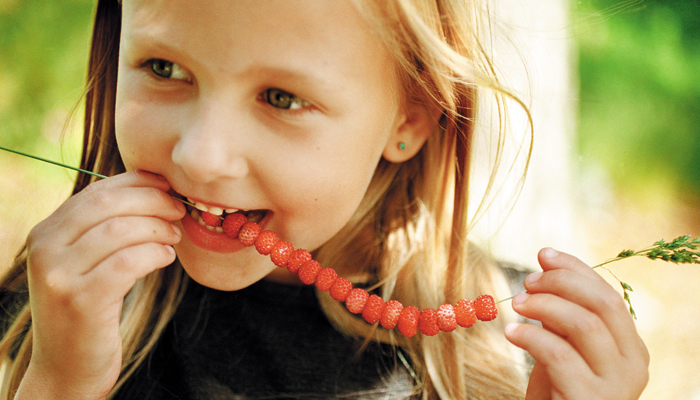
My interest in food goes back as far as I do: Being hungry is my earliest memory, and the urge to eliminate hunger governed my life. As a small child, I was both greedy and lazy—at least that is what my parents tell me. And as a baby, I didn’t really see the point of walking when I could just continue being carried, as I always had.
Then, one fine summer day in 1974, when I was a little more than a year old, my father placed me in front of a row of raspberry bushes and left me there. Sitting down, I could reach maybe one or two of the beautiful red berries. They were sweet and perfectly ripe. I uttered a demanding sound, as if to say, “More berries!” But there was no one there to obey my commands. If I was going to get more of the juicy berries, I had to stand up. I rose to the occasion, so to speak, and picked a few. And once I was standing, I could see more raspberries, big, crimson red, juicy, velvety raspberries, each one sweeter than the next—just a few feet farther away. I had to choose between my laziness and my hunger. The temptation was too much—hunger won.
When my father peeked around the corner to see how I was doing, he saw me walking to the other side of the bushes as if it were the most natural thing in the world. I held a berry out for him, my face red with juice and full of pride. The berry fell to the ground. I looked and suddenly noticed how far down it was. I stumbled, fell, and started crying. But this time my father didn’t have to pick me up. All he had to do was to point and say, “Look, there’s another one.” And I got up.
The world, it turned out, was packed with good things. But few can compare to the summer weeks, when life revolves around a few raspberry bushes, when you do not even feel guilty for all the things you should have done, the time when nature, in a short burst of energy, hands us the sweetest berries imaginable and people in the coldest country in the world can finally enjoy the reward for all their patience.

DIFFERENT VERSIONS OF THIS PUDDING CAN BE MADE ACCORDING TO THE SEASON, SOMETIMES USING A COMBINATION OF RASPBERRIES AND CURRANTS, SOMETIMES RASPBERRIES AND STRAWBERRIES. COMMON TO ALL VERSIONS IS A THICKENED BERRY PUREE SERVED WITH SLIVERED ALMONDS AND CREAM. I USE A LITTLE BIT OF WHITE WINE AND VANILLA IN MY RECIPE, AND ALTHOUGH SOME TRADITIONALISTS MAY FROWN WHEN I TELL THEM, FEW DO WHEN THEY TASTE THE RESULT.
SERVES 6
1½ pounds raspberries
½ pound red currants, stemmed
½ cup dry white wine
2 to 4 tablespoons superfine sugar, or more to taste
½ vanilla bean, split lengthwise in half
2 teaspoons cornstarch or potato starch
1 pound strawberries, hulled and coarsely chopped
¼ cup slivered almonds
½ cup heavy (whipping) cream
Place the raspberries and red currants in a blender or food processor and blend until pureed.
In a stainless steel saucepan, bring the wine to a boil. Add the raspberry and red currant mixture, 2 tablespoons of the sugar, and the vanilla bean. Simmer over low heat for 10 minutes. Add the cornstarch, stir, and gently bring to a boil. The pudding should thicken somewhat but still be rather loose. Add more sugar to taste if necessary. Add the strawberries, bring to a boil, and remove from heat. Transfer to a bowl, cover, and refrigerate for at least 1 hour.
Spoon the pudding into individual bowls. Sprinkle with slivered almonds and serve the cream in a pitcher on the side.
This is a traditional Danish dessert, and although all the Scandinavian languages are closely related, the name of this dish—rødgrød med fløde—can really be pronounced only by Danes. In the words of cookbook writer Dale Brown, Danes let the name “slide out of their lips as smoothly as cream from a spoon.”
IF THERE IS A NATIONAL SUMMER DESSERT IN NORWAY, IT MUST BE SUMMER BERRIES WITH VANILLA CUSTARD.
THE CUSTARD CAN BE SERVED HOT, WARM, OR COLD. IT WILL KEEP FOR UP TO TWO DAYS IN THE REFRIGERATOR.
SERVES 4 TO 6
5 large egg yolks
¼ cup superfine sugar
1 cup whole milk
1¼ cups heavy (whipping) cream
2 to 3 bay leaves, preferably fresh, plus 4 to 6 for garnish (optional)
2 pounds mixed berries, such as blueberries, strawberries, raspberries, and/or currants, stemmed and/or hulled
In a medium bowl, whisk the egg yolks and sugar together until pale and thick.
In a medium saucepan, combine the egg yolk mixture, milk, cream, and bay leaves. Heat gently over medium-low to low heat, stirring constantly, until the custard thickens enough to leave a velvety coating on the back of a wooden spoon. (If you are using a thermometer, the custard should reach about 175°F.) Do not let the mixture boil or it will curdle. Remove it from the heat as soon as you have obtained the right thickness and continue stirring for 2 more minutes. Leave the bay leaves in the custard while it cools, then remove them.
Place the berries in dishes, pour the custard over, garnish with bay leaves, if desired, and serve.
My grandmother picks red currants and wild raspberries every summer morning. Then, just before supper, she makes custard, filling the old farmhouse with the maddeningly delicious aromas of berries and vanilla.
Once there was no vanilla to be found in the house, not even poor substitutes like vanilla sugar or vanilla extract. “You think of something to add,” my grandmother told me in her warm yet demanding way. After rummaging through the shelves, the only candidates I could find were a few dry bay leaves. Neither of us was all too optimistic about the experiment, but when the custard was done, it was delicious. I find the bay leaf version to be more interesting and complex than the traditional vanilla custard.
Bay leaves are mostly used in savory dishes, but if you crush a bay leaf in your hand, close your eyes, and take a deep breath, you will notice that it has an aromatic sweetness to it, like a pleasant combination of cinnamon, nutmeg, vanilla, and cardamom.
Even though bay leaves keep well when dried, fresh ones have the most intense and complex flavor. If you have a favorite vanilla custard, feel free to stick with that recipe and just replace the vanilla with bay leaves.

In Norway, summer does not merely mean sun and warmth, it is compensation for the long, dark winter, and it is savored hungrily. Even in the capital, Oslo, in the south of the country, the sun does not set until nearly 11 P.M., and it quickly rises again before 4 A.M. In northern Norway, the sun never sets. In June and July, outdoor restaurants and beaches are overcrowded with sun seekers, and after a few long days of sun and temperatures in the eighties, we forget how on a cold, dark day in January we regretted being born in one of the northernmost countries in the world.
The true sign that summer has arrived comes in June, when the first Norwegian strawberries start to appear in shops. Highly regarded by most people, strawberries are seen by Norwegians as the true essence of summer, something few could imagine living without. During Norway’s national vacation in July, stalls are put up along all the roads to sell nothing but fresh strawberries.
In June, the first berries from the south-facing slopes of the Lier Valley, close to Oslo, hit the stores. They are juicy, sweet, and just a little bit tart, best eaten with sugar and cream or as a part of the traditional cream cake. The first strawberries are typically the Zephyr or Honey varieties—followed by Korona and the poetically named Senga Sengana and, toward the end of the season, Bounty and Dania.
As summer progresses, and strawberries from farms farther north start coming in, the berries get sweeter and sweeter. By mid-July, the somewhat smaller berries from Trøndelag, in the middle of the country, are ripe. They hardly need any sugar at all. If they are combined with other fruits or berries, they will seem almost overpowering, and while I am usually skeptical of combining normal strawberries with chocolate, the Trøndelag berries are up to the challenge.
Then, toward the end of July or the beginning of August, the season culminates with the berries from Harstad, north of the Polar Circle, the northern-most commercially grown strawberries in the world (but facing stiff competition from a few Swedish farms almost at the same latitude). If the summer has been colder than average, the berries will not have had time to ripen at all before the cold northern-Norwegian autumn finishes them off. But in good years, the crimson Harstad berries are a worthy conclusion to summer. Their aroma is almost as intense as wild strawberries’, and their flavor is just as wonderful. I have not yet come across a way to serve the berries that makes them better than the way nature—and the ever-present sun—made them.
THIS SIMPLE MOUSSE IS A VARIATION ON STRAWBERRIES WITH SUGAR AND CREAM. IT IS MADE WITHOUT ANY FORTIFIERS AND IS THEREFORE FRESHER TASTING THAN MANY OTHER MOUSSES. YOU SHOULD MAKE IT JUST BEFORE SERVING OR IT MAY COLLAPSE SLIGHTLY AND BECOME RUNNY. JUST HOW MUCH SUGAR YOU USE DEPENDS ON HOW SWEET YOUR BERRIES ARE.
SERVES 6 TO 8
1 pound strawberries, hulled and halved
½ to 1 cup confectioners’ sugar
3 cups heavy (whipping) cream
1 to 2 tablespoons fresh lemon juice, to taste
Combine two-thirds of the strawberries and half the sugar in a blender and puree until smooth. Add more sugar to taste. Press the pureed strawberries through a fine sieve to remove the seeds.
Just before serving, whip the cream in a large bowl until stiff. Coarsely chop the remaining strawberries. Dust the chopped berries with a little sugar and sprinkle with the lemon juice. Gently fold the pureed and chopped strawberries into the cream and serve.
VARIATION: You can make all kinds of variations on this mousse by adding either some vanilla seeds or some finely chopped fresh thyme, basil, or even rosemary to the cream. Or serve in ice cream cones or caramel baskets for a nice, crispy contrast to the smooth mousse.
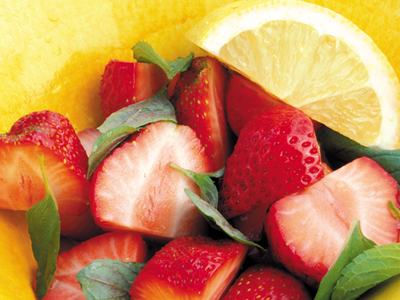
A PARFAIT IS PERHAPS NOT “PERFECT,” AS ITS FRENCH NAME INDICATES, BUT IT IS A REFRESHING WAY TO CONCLUDE A MEAL. AND MAKING A PARFAIT IS MUCH SIMPLER THAN MAKING EITHER ICE CREAM OR A PROPER FORTIFIED MOUSSE. IT CAN BE PREPARED A DAY IN ADVANCE, BUT IT IS BEST WHEN JUST FROZEN.
SERVES 8 TO 10
3 cups heavy (whipping) cream
2 large egg whites (optional)
5 large egg yolks
⅔ cup superfine sugar
1½ cups wild blueberries, blackberries, or black currants
8 fresh mint leaves, finely chopped
3 tablespoons coarsely grated bittersweet chocolate, or more to taste
In a large bowl, whip the cream until stiff. In a medium bowl, beat the egg whites until stiff. Gently fold the whites into the whipped cream.
In a medium bowl, whisk together the egg yolks and sugar until thick and pale. Whisk in 1 cup of the blueberries and the mint, beating until most, but not all, of the berries burst and the mixture turns dark violet. Fold the blueberry mixture gently into the whipped cream.
Transfer the parfait mixture to a 1½-quart mold, or leave it in the bowl. Cover with plastic and place in the freezer for at least 8 hours.
Forty minutes before serving, transfer the parfait to the refrigerator.
To serve, place the mold in warm water for a few seconds and invert the parfait onto a serving plate. Garnish with the rest of the berries and the chocolate and serve immediately.
Commercially grown blueberries do not have the intense color and flavor of the wild berries, which make this dish interesting to eat and pretty to look at. If you cannot find wild blueberries, substitute blackberries or black currants.
If you are not absolutely sure that your eggs are safe, I suggest you use pasteurized raw egg yolks and omit the raw egg whites.

Cloudberries grow in the Arctic and sub-Arctic areas of the Nordic countries and North America. The berries have a deep red color when nearly fully ripe, then change to golden with a tinge of orange when ripe. Their shape resembles a raspberry, but their flavor is more like deep caramel or baked apples than that of any other berry (the cloudberry variety that grows in Canada and Alaska is often referred to as “baked apple berry”)—and, surprisingly, it is not sweet. The long days and cool weather in the highlands give the aromas time to develop, but there is not enough warmth for the berries to produce sugars.
I decided to embark on a quest for the illustrious cloudberry and ended up in Koppang, five hours north of Oslo. I soon learned however, that picking cloudberries is not easy. The low bushes are almost impossible to spot. The first day there, I spent hours head down, bottom up, searching the moors, unable to find more than a pound of the golden berries, most of which I ate as I picked them. The next two days I had better luck, but still I returned to the city with only two 3-quart containers, much less than I had hoped for.
Luckily, just a few cloudberries go a long way—their intense flavor encourages slow savoring. Because they are not sweet, they can be served with game and other meats, but first and foremost, they are used to make cloudberry cream—whipped cream, sugar, and cloudberries combined to make a delicious dessert that is like a cloud wherein all the flavors of the intense Arctic summer are captured.
BECAUSE THEY ARE SO RARE AND THEIR FLAVOR SO MILD AND EPHEMERAL, CLOUDBERRIES ARE ALWAYS SERVED THE SIMPLEST WAY POSSIBLE, EITHER AS CLOUDBERRY CREAM OR AU NATUREL WITH CREAM AND SUGAR ON THE SIDE. SOME CLOUDBERRY PURITANS WILL PROBABLY THINK MY ADDITION OF A HINT OF ROSEMARY AND VANILLA IS A DANGEROUS EXPERIMENT, BUT I FIND THAT BOTH FLAVORS ADD SOMETHING INTERESTING TO THE BERRIES, WITHOUT BECOMING TOO DOMINANT.
SERVES 2-4
1 pound cloudberries or 1 pound cloudberry preserves (see sidebar)
6 tablespoons sugar, or more to taste, if using fresh berries
3 cups heavy (whipping) cream
1 vanilla bean, split lengthwise in half
2 tablespoons finely chopped fresh rosemary
If using fresh cloudberries, sugar them to taste. They should be pleasantly sweet but still have a little tartness.
Pour the cream into a large bowl. Scrape the black seeds out of the vanilla bean and add to the cream. Whip the cream until stiff. Fold in the cloudberries and rosemary. Serve immediately.
If you cannot get hold of fresh cloudberries—and, unless you live in the northern United States, where they grow wild, this will likely be the case—you can substitute cloudberry preserves and will probably not need any sugar. If you cannot find cloudberries in a local shop, try ordering them by mail (see Mail-Order Sources).
NORWEGIAN PANCAKES ARE QUITE DIFFERENT FROM AMERICAN PANCAKES. THEY ARE NOT LEAVENED AT ALL AND ARE MORE LIKE A COMBINATION OF A FRENCH CRÊPE AND A THIN OMELET. LIKE CRÊPES, THEY CAN BE SERVED EITHER AS A DESSERT OR AS A SAVORY DISH. IT ALSO QUITE COMMON TO SERVE PANCAKES WITH STRAWBERRIES OR BLUEBERRIES AND SUGAR FOR DINNER.
MY FATHER IS A MASTER PANCAKE MAKER, AND WHEN I WAS A CHILD, WE HAD PANCAKES FOR DINNER ONCE A WEEK.
SERVES 2 TO 4
⅔ cup all-purpose flour
¼ teaspoon salt
3 large eggs
1½ cups whole milk
1 tablespoon sugar or honey, plus more for serving
3 tablespoons unsalted butter, melted, plus butter for cooking
Blueberries or strawberries for serving
Combine the flour and salt in a medium bowl. Add the eggs, milk, and sugar, stirring with a fork until you have a light batter; make sure there are no lumps. Stir in the melted butter. Let rest for 30 minutes.
Heat 2 teaspoons butter over medium heat in a cast-iron or other heavy skillet. Add ⅓ cup of the batter and immediately tilt the skillet so that the batter spreads out evenly. Cook for approximately 3 minutes, until the batter has set on top, then flip, using a spatula. Cook for 2 minutes, then transfer to a plate. Repeat, stacking the cooked pancakes, until you have used all the batter.
Serve the pancakes warm with berries and sugar.
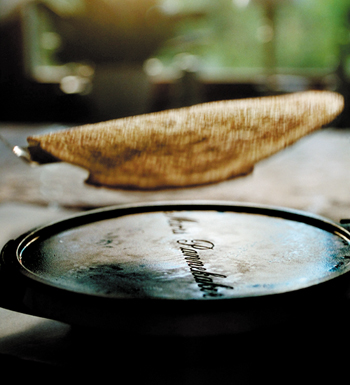
When I was a child, of all the things the grown-ups ate, two were completely incomprehensible to me: red wine and rhubarb, sour-tasting things that did not even try to please but instead filled your mouth with a nasty, numb dryness. Rhubarb was the worst, since that was the one I was subjected to—every year, as summer approached, I would watch the reddish stalks grow with furious energy, dreading the day the grown-ups would discover them and decide to make a terrible acidic rhubarb soup, almost without sugar, cooked for hours until the rhubarb had disintegrated into a thick pulp.
I would protest, naturally, but it was useless. “You have got to taste it. Maybe you will like it now” was the standard, merciless command. The amount of soup made was enormous, and if it was not finished, which it seldom was, it was recycled as a refreshment. “If the rhubarb hates summer so much, why can’t it grow in winter?” I asked. There was no reply.
Today I know that the rhubarb is not to blame. It knows of only one existence, that of an angry, acerbic lust for life. If it is to be enjoyed by humans, it has to be subdued by a staggering amount of sugar. It was not until I wrote a cookbook with restaurateur and chef Sissel Kvello that I tasted a really good rhubarb soup. The soup she made contains white wine, vanilla, and cinnamon, and it is not cooked for hours. Sissel’s rhubarb soup is now one of my favorite summer desserts. It is just interestingly tart, quite spicy, and so sweet that you can feel the blood sugar pumping around in your veins—everything my childhood’s rhubarb dishes were not.
WHILE RHUBARB IS INCREDIBLY SOUR AND TAKES A POTENTIALLY DIABETES-PROVOKING AMOUNT OF SUGAR TO MAKE IT ENJOYABLE ENOUGH TO EAT, I THINK IT SHOULD BE ALLOWED TO KEEP SOME OF ITS REBEL CREDENTIALS. RHUBARB SOUP SHOULD BE TART AND REFRESHING. ADDING THE SWEET AROMAS OF VANILLA AND CINNAMON WILL ALLOW YOU TO USE SOMEWHAT LESS SUGAR. I PREFER TO USE A DRY WHITE WINE THAT HAS NOT BEEN AGED IN OAK BARRELS, BUT YOU CAN USE ANY DECENT WHITE WINE YOU LIKE.
SERVES 4
1 pound young rhubarb stalks, trimmed and cut into 1½-inch pieces
½ cup sugar, or more to taste
2½ cups water
1 cup dry white wine
1 vanilla bean, split lengthwise in half
1 small cinnamon stick (approximately 2 inches)
2 teaspoons potato starch or cornstarch (optional)
12 to 16 strawberries, hulled and sliced
1 tablespoon chopped fresh mint
Sour cream for serving (optional)
In a stainless steel pot, combine the rhubarb, sugar, water, white wine, vanilla bean, and cinnamon stick (do not use a copper, iron, or aluminum pot, as they can be discolored by the strong acidity from the rhubarb and may affect the taste of the soup). Bring to a boil over medium-high heat, reduce the heat to medium-low, and simmer gently for 25 minutes, or until the rhubarb is very soft.
Remove the cinnamon and vanilla and discard the cinnamon. Scrape the remaining seeds out of the vanilla bean with the back of a knife and return them to the soup. Discard the bean. If you want the soup to have a somewhat thicker consistency, add the potato starch and bring to a boil. Remove from the heat. Add half the strawberries to the soup and set aside to cool.
Pour the soup into deep bowls, garnish with the mint, the remaining strawberries, and sour cream, if desired, and serve at room temperature or chilled.
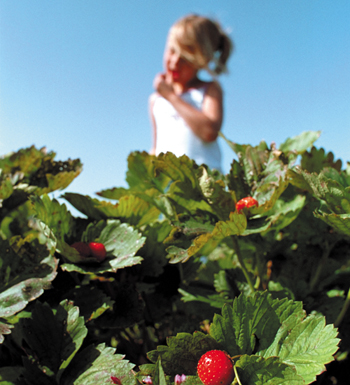
“Bees are something you do not understand, Andreas. But when you do, new horizons will open up to you,” my grandfather once told me in a rare moment of grandparental conversation. My grandfather was normally a man of few words and even fewer opinions, and I felt tremendously privileged to have been found worthy of his confidence. And he was most certainly right. I did not understand, but I immediately started guessing what his cryptic message could mean. Then, a few moments later, he added, as if to clarify: “You see, bees make honey.”
I knew that, did I not? There was nothing mystical about that. At first I was truly disappointed. Was that all there was to my grandfather, was that all the wisdom he hid behind his gloomy and quiet exterior?
Honey is nectar from flowers, gathered by bees and broken down by their saliva. It is as simple as that—yet that cannot be all there is to it. There is a magic surrounding the transformation of plain sweet nectar into golden honey, something that cannot be explained in full by chemists, something only a lifelong fascination with bees can make familiar, but even then never fully understandable.
I always loved the smell of my grandparents’ basement, where my grandfather kept his beekeeper workshop. He would oftentimes let me taste honey straight from the comb. And, in a way that anyone who has had a profound childhood experience of something wonderful will recognize, honey will always mean something special to me. As time has passed, I have learned to appreciate the many different kinds of honey.
The first honey of summer is light and translucent, tasting of apple and raspberry blooms. Later, as summer evolves, the honey develops deeper and more intense flavors. And it also varies from region to region, according to vegetation. When there is a lot of clover and Indian cress (nasturtium), the honey will have a nice spiciness to it. I have friends in Oslo who make their own honey in the middle of town. The bees fly off to gather nectar in parks, gardens, and balcony flower boxes, producing a honey that is the sweet fingerprint of the city. But the most important honey in Norway, what the country is famous for, is heather honey.
During summer, many beekeepers transport their beehives from their farms to the highlands, where the bees gather the nectar from heather, cloudberry flowers, and other mountain plants. The result is an opaque yellow honey, so thick that it will not pour, and with so much flavor that adding just a teaspoon of it to a cup of tea is enough to fill the whole room with the sweet scent of heather.
I have made many attempts to grasp what my grandfather meant by his cryptic statement, and I think I am beginning to see what he sought in his bees. Perhaps he, like the Belgian author and Nobel laureate Maurice Maeterlinck, saw in the bees a more perfect society, a life with a purpose that could never be questioned. “The bee may not be the world’s most intelligent creature, I will not argue with you about that,” Maeterlinck wrote in La Vie des Abeilles (The Life of the Bee) in 1901. “But the bee has found a way to prevent cold and hunger, death, time, and loneliness, and all those enemies that threaten our own lives. The toil is hard, but the reward is sweet.”
When my grandfather dressed in his white beekeeper costume and went out to tend to his small brown and yellow bees, he was fully content. Once I even found him singing to his bees in a frail, rusty voice, while the bees walked peacefully over his old hands. At moments like that, he seemed at peace, with himself and with the world. I believe he admired and envied the small creatures. The bees do not wrangle, they do not talk about insignificant things. They stay where they belong and, most of all, they work. And when fall arrives, and the bee has fulfilled its obligations to the world, it does not sit down to feast. Instead it lies down to die. It is not difficult to see the poetry in that.
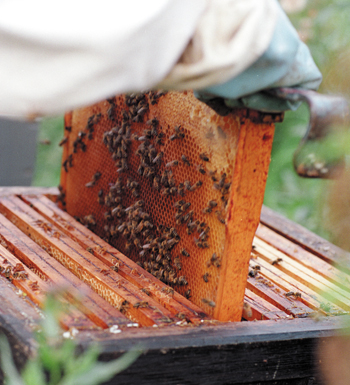
SERVES 4
4 sweet apples, such as Golden Delicious
¼ cup honey
2 tablespoons finely chopped ginger
2 tablespoons unsalted butter
4 teaspoons sour cream, or more (optional)
Preheat the oven to 450°F.
Remove the core from each apple without cutting all the way through, forming a hollow ⅔ inch to 1 inch in diameter. (If you are preparing the apples in advance, brush them with lemon juice to prevent discoloring.) Place the apples in a baking dish. Fill the cavities with the honey and chopped ginger and top each one off with a small lump of butter.
Bake on the lowest oven rack for about 45 minutes, until the apples are tender. Check on the apples every once in a while—if there are signs that the honey is burning, turn down the heat.
Serve hot or warm, topping each apple with a teaspoon or more of the sour cream, if desired.
Ginger, although undeniably a very “exotic” and Eastern spice to many, has been known in Scandinavia at least since the sixteenth century, perhaps as far back as the fourteenth century.
Ginger was originally used for medicinal purposes, but it gradually worked its way into many Scandinavian cakes and desserts.
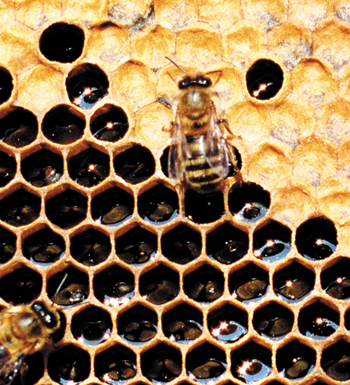
THIS IS A LOVELY, SLIGHTLY TART DESSERT THAT WILL HELP PICK YOU UP AFTER DINNER. SIMPLE TO MAKE, IT CAN BE PREPARED IN ADVANCE, AND IT CAN BE SERVED WITH NOTHING BUT ITS OWN SYRUPY COOKING JUICES AND, PERHAPS, SOME WHIPPED CREAM.
SERVES 4
4 sweet apples, such as Golden Delicious
1 vanilla bean
6 tablespoons superfine sugar
⅔ cup lingonberries or cranberries, halved, or ⅔ cup lingonberry preserves (see sidebar)
Sweetened whipped cream (optional)
Preheat the oven to 400°F.
Remove the core from each apple without cutting all the way through, forming a hollow ⅔ inch to 1 inch in diameter. Remove the peel from the upper quarter of each apple. (If you are preparing the apples in advance, brush them with lemon juice to prevent discoloring.)
Place the apples in a baking dish. Cut the vanilla bean lengthwise in half. Remove the small seeds with the back of a knife and rub the exposed flesh of the apples with the seeds. Dust the flesh with 3 tablespoons of the sugar. Cut the half beans in two and place one in each apple. (The beans will perfume the apples nicely as they cook.) Fill the apples with the lingonberries. There will not be room for all the berries, so scatter the rest of them around the apples in the dish. Top off the berries with the rest of the sugar (if you are using preserves, no more sugar is needed).
Bake on the lowest oven rack for 45 minutes, or until tender, spooning the cooking juices over the apples once or twice. Serve warm, with whipped cream, if desired. Remove the vanilla bean before eating.
The lingonberry is a northern European relative of the cranberry, smaller and more sour than the cultivated American cranberry, but not unlike the wild variety. Both berries derive their names from similar—and equally dubious—assumptions: The cranberry was long thought to have been the favorite food of cranes, and the lingonberry was said to have been preferred by cows, lingon in Swedish. You can buy frozen lingonberries and lingonberry preserves in Scandinavian specialty stores or by mail (see Mail-Order Sources), or substitute cranberries. If you are using sugared lingonberry preserves, reduce the sugar to ¼ cup.
I made this dish on the New Scandinavian Cooking program from Lofoten in northern Norway, where it was so cold that some of the lingonberries on the plate froze, while the apples were still scorching hot inside.
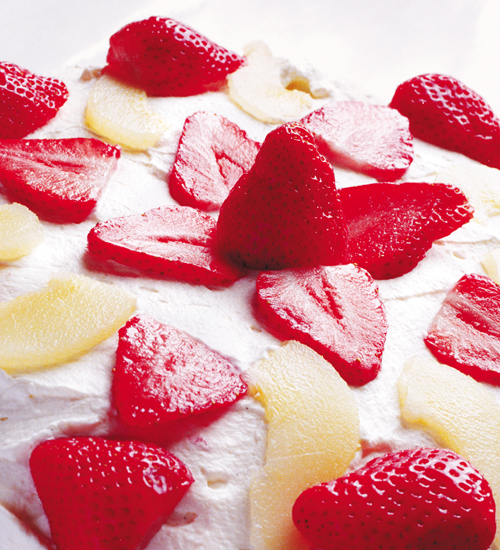
CREAM CAKE IS MEANT TO BE THE KIND OF CAKE YOU CAN EAT A LOT OF WITHOUT FEELING FULL. TO ACHIEVE THAT, YOU HAVE TO CREATE A VERY LIGHT SPONGE CAKE. IN SUMMER, WHEN STRAWBERRIES ARE AT THEIR BEST, YOU CAN MAKE THE CAKE WITH FRESH BERRIES ONLY, BUT THE REST OF THE YEAR, IT IS BETTER TO RELY ON A COMBINATION OF FRESH OR FROZEN BERRIES AND CANNED FRUIT. I DOUSE THE SPONGE CAKE WITH A COMBINATION OF CALVADOS AND SYRUP FROM THE PEARS, BUT ORANGE OR STRAWBERRY JUICE IS JUST AS GOOD.
SERVES 8 TO 10
FOR THE SPONGE CAKE
1 teaspoon unsalted butter
4 large eggs, separated
1 cup superfine sugar
1 cup all-purpose flour
2 teaspoons baking powder
FOR THE FILLING
1 vanilla bean, split lengthwise in half
One 15-ounce can pears in light syrup, drained, syrup reserved
1 tablespoon finely chopped fresh rosemary
4 cups heavy (whipping) cream
½ cup superfine sugar, or more to taste
1 pound strawberries, hulled
2 tablespoons Calvados or eau-de-vie (optional)
¼ cup strawberry or orange juice (optional)
Preheat the oven to 350°F. Grease a 10-inch nonstick round cake pan or springform pan with the butter.
To make the sponge cake, beat the egg whites in a large bowl until stiff peaks form. In another large bowl, beat the egg yolks and sugar together until pale and thick. Sift together the flour and baking powder, and beat into the egg mixture. Fold in the beaten egg whites as gently as possible. Pour the batter into the prepared pan.
Bake in the middle of the oven for 30 to 35 minutes, until a toothpick inserted in the center comes out clean. Let the cake rest for 10 minutes before you remove it from the pan, then let it cool completely on a rack.
To make the filling, scrape the seeds from the vanilla bean with the back of a knife, and reserve for later. Cut the pears into thin slices. Set aside a few of the nicest slices for decoration (brush them with lemon juice to prevent discoloring).
In a nonstick skillet, combine the rest of the pears, the vanilla bean (not the seeds), and the rosemary and cook over medium heat for 5 minutes, or until the pears start to lightly brown. (If the pears dry out completely, add a little of the reserved syrup.) Remove the vanilla bean and discard. Set aside to cool.
Whip the cream in a large bowl until stiff. Add the sugar. Transfer approximately one-third of the cream to two small bowls, dividing it evenly.
Reserve 8 of the nicest strawberries for decoration. Puree two-thirds of the remaining berries in a blender, or push them through a sieve using the back of a spoon. Coarsely chop the rest of the berries and mix with the puree in a bowl. Gently fold the strawberry mixture into one of the small batches of whipped cream. If necessary, add more sugar to taste, but the mixture should still have some gentle tartness left.
Stir the vanilla seeds into the other small batch of whipped cream.
With a long, thin knife, cut the cake into three layers. Place the bottom layer of the cake on a large serving plate. Soak the cake with some of the syrup from the pears. Sprinkle with the Calvados, if using. Arrange the pears on top. Spread the vanilla cream over the pears. Add the second layer of sponge cake. Soak the cake with strawberry juice, if using. Spread the strawberry cream over the layer. Place the final layer on top. Frost the entire cake with a thick layer of cream. Decorate the cake with the reserved strawberries and slices of pears. Serve immediately.
In an American book on Scandinavian food from the 1960s, Norwegian cream cake is dismissed as “a cake consisting almost exclusively of cream.” This is not exactly a misstatement, but it shows a deep lack of understanding. Whereas a cheesecake or chocolate cake, for example, is supposed to be heavy and full of flavor, the cream cake is featherlight, fresh, and festive. Cream cake is normally served on May 17, Norway’s constitution day, and at birthday parties, weddings, and other special occasions.
SERVES 4
1½ cups bread crumbs
3 tablespoons superfine sugar
2 teaspoons ground cinnamon
2 tablespoons unsalted butter
1½ cups heavy (whipping) cream
1½ cups applesauce, chilled
½ cup chopped hazelnuts
In a nonstick skillet, combine the bread crumbs, sugar, cinnamon, and butter. Stirring constantly with a heatproof spatula or wooden spoon, heat over medium heat until the crumbs are uniformly golden. Remove from the heat.
In a large bowl, whip the cream until stiff.
Layer the applesauce, bread crumbs, and cream in individual glass bowls. (I prefer at least two layers of each.) The top layer should always be whipped cream, “veiling” the dish. Sprinkle with the chopped nuts and serve.
This is a traditional dessert that both Norway and Denmark lay claim to. Given our colonial history, though—Norway was subject to Denmark’s rule for nearly four hundred years—there is reason to believe that the Danes invented the dish.
How it got its name is easy to understand: It consists of layers of applesauce and sweet cinnamon-scented bread crumbs, veiled with whipped cream.
JUNIPER BERRIES ARE IMPORTANT IN SCANDINAVIAN COOKING, BUT USING THEM IN DESSERTS IS NOT COMMON. I PREPARED THIS DESSERT WHILE WE WERE IN SVALBARD TAPING NEW SCANDINAVIAN COOKING. I FOUND THAT THE SPICES LENT AN INTERESTING LAYER OF FLAVORS AND AROMAS TO THE GENTLE AND UNCOMPLICATED PEAR. WITH THE WARM SWEETNESS OF HONEY AND THE CLEAN SPICINESS OF GINGER, THIS DEVELOPED INTO A DELICIOUS AND UNEXPECTED DESSERT.
SERVES 4
¼ cup honey, preferably heather honey
1 tablespoon unsalted butter
4 pears, such as Anjou, peeled
2 tablespoons finely chopped ginger
8 juniper berries, ground or finely crushed
¼ teaspoon chili powder
½ cup heavy (whipping) cream
1 teaspoon caraway seeds, crushed
1 tablespoon aquavit (optional)
1 tablespoon superfine sugar
In a large nonstick skillet, heat the honey and butter until a dark caramel starts to form in the center of the pan. Immediately reduce the heat and add the pears, ginger, juniper berries, and chili powder. Cook the pears, turning them every few minutes, for 20 minutes over medium-low heat, or until tender but still somewhat firm near the core. Remove from the heat.
Whip the cream in a small bowl until stiff. Fold in the caraway seeds, aquavit, if using, and sugar.
Place the pears on plates and spoon the honey caramel sauce over, followed by the whipped cream. Serve immediately.
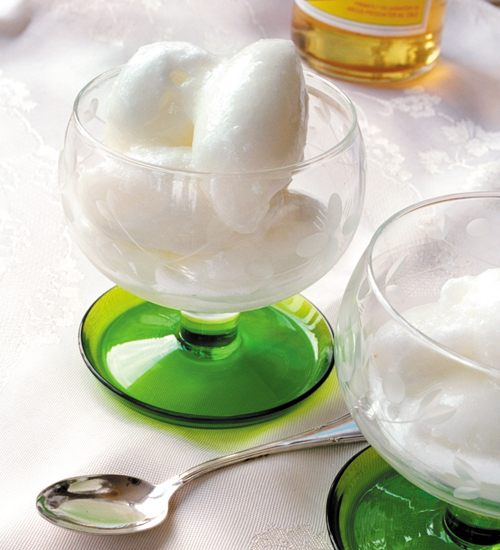
THE SPICY CARAWAY FLAVOR OF AQUAVIT IS NOT WHAT MOST PEOPLE ASSOCIATE WITH A DESSERT, BUT WHEN MIXED WITH SUGAR, AQUAVIT MAKES A VERY INTERESTING AND REFRESHING SORBET. IF YOU REDUCE THE SUGAR BY HALF, THIS CAN ALSO BE SERVED AS A PALATE CLEANSER BETWEEN COURSES.
SERVES 6 TO 8
1 cup superfine sugar
2 tablespoons finely grated lemon zest
2½ cups water
¼ cup fresh lemon juice
⅔ cup aquavit
In a small saucepan, combine the sugar, lemon zest, and water and bring to boil over high heat. Boil over medium heat for 5 minutes. Add the lemon juice and set aside to cool.
Strain the syrup into a bowl. Add the aquavit and place the bowl in the freezer. Take out and stir energetically with a fork every 30 minutes until completely frozen.
If the sorbet is frozen hard, let it soften briefly in the refrigerator before serving.
Serve with fruits or lightly toasted slivered almonds.
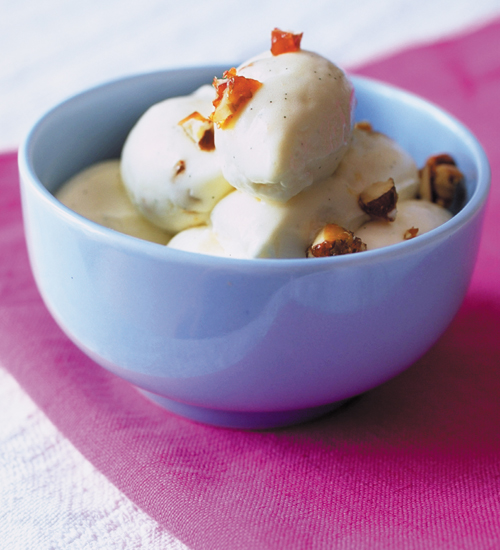
I MADE MY OWN ICE CREAM IN AN OLD HAND-CRANKED ICE CREAM MACHINE FOR A NEW SCANDINAVIAN COOKING SEGMENT WE TAPED FROM THE OSLO FJORD. IT IS, HOWEVER, ABSOLUTELY PERMISSIBLE TO USE A GOOD COMMERCIALLY MADE VANILLA ICE CREAM AND JUST MIX IN THE ALMOND BRITTLE.
THE ICE CREAM CAN BE FROZEN FOR UP TO 1 WEEK. IF IT IS FROZEN HARD, LET IT SOFTEN SLIGHTLY IN THE REFRIGERATOR BEFORE SERVING.
MAKES 1½ QUARTS
FOR THE ICE CREAM
2½ cups whole milk
1½ cups heavy (whipping) cream
1 vanilla bean, split lengthwise in half
10 large egg yolks
1 cup sugar, plus more to taste
FOR THE ALMOND BRITTLE
⅔ cup sugar
1 tablespoon unsalted butter
½ cup slivered almonds
2 tablespoons chopped hazelnuts
To make the ice cream, combine the milk and cream in a large saucepan. Scrape out the small black seeds from the vanilla bean and add both the bean and seeds. Heat until almost boiling. Keep hot over low heat, stirring occasionally.
In a large bowl, whisk together the egg yolks and sugar until thick and pale. Little by little, add the hot milk and cream mixture, whisking constantly. The mixture should thicken into a smooth, thick custard that leaves a thick film on the back of a spoon; if the custard is still too thin, return it to the pan and heat, whisking continuously, until thickened (it should reach about 175°F on a candy or instant-read thermometer). Do not overheat or the custard will curdle. Let the custard cool until lukewarm, then chill in the refrigerator (or freezer) until very cold.
Freeze in an ice cream machine according to the manufacturer’s instructions, transfer to an airtight container, and freeze. Or, if you do not have an ice cream machine, transfer the custard to a container with a tight-fitting lid and place the container in the freezer. Take the custard out every 20 minutes and stir it with a spatula, making sure to scrape the frozen crystals from the sides of the container, until the ice cream is frozen and it gets difficult to move the spatula around. Return to the freezer.
To make the almond brittle, cover a table with parchment paper. Heat a large nonstick skillet over medium-high heat. Add the sugar and butter and cook until the sugar has melted and you have a golden brown caramel. Add the almonds and hazelnuts, stirring to coat. Immediately pour the caramel onto the parchment paper and spread it out with a spatula until ¼ inch thick. Let cool.
Coarsely chop the almond brittle. Mix most of the almond brittle into the ice cream and return it to the freezer until ready to serve. Reserve the remaining almond brittle for garnish.
This is the traditional Scandinavian ice cream. There are related ice creams with nougat in France and Italy, but I have not tasted anything like the deliciously crunchy krokanis, as it is called in Norwegian.
Serve with fresh strawberries, if you like.